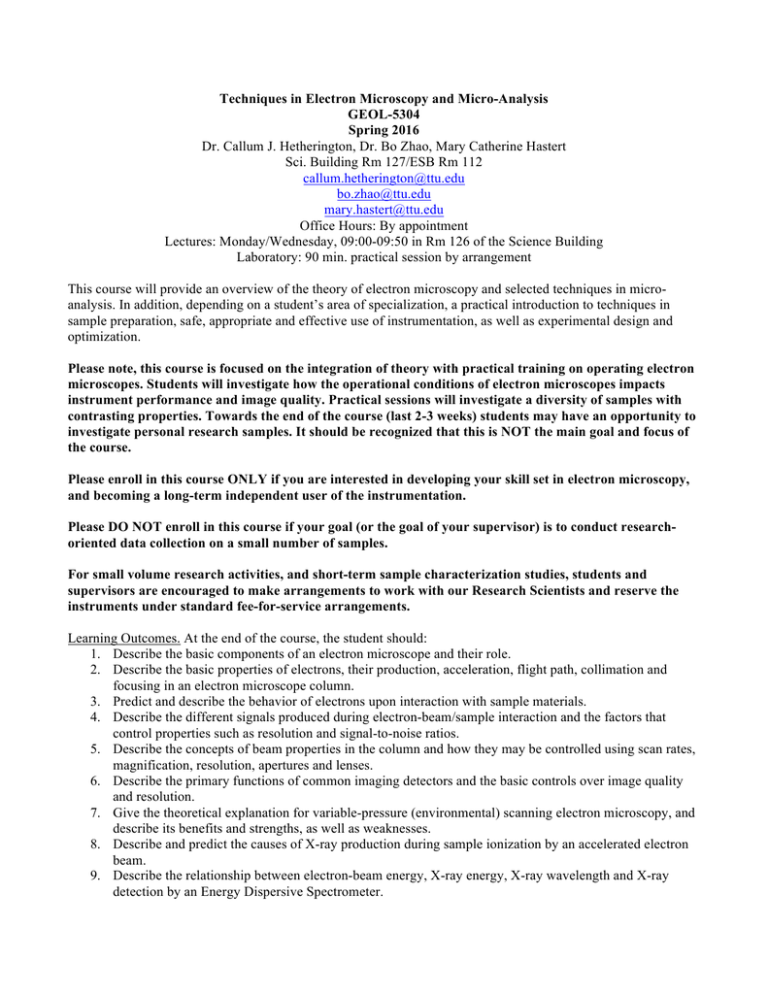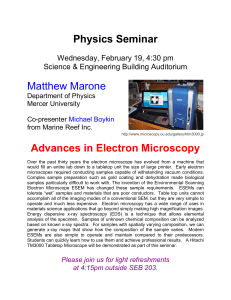Techniques in Electron Microscopy and Micro-Analysis GEOL-5304 Spring 2016
advertisement

Techniques in Electron Microscopy and Micro-Analysis GEOL-5304 Spring 2016 Dr. Callum J. Hetherington, Dr. Bo Zhao, Mary Catherine Hastert Sci. Building Rm 127/ESB Rm 112 callum.hetherington@ttu.edu bo.zhao@ttu.edu mary.hastert@ttu.edu Office Hours: By appointment Lectures: Monday/Wednesday, 09:00-09:50 in Rm 126 of the Science Building Laboratory: 90 min. practical session by arrangement This course will provide an overview of the theory of electron microscopy and selected techniques in microanalysis. In addition, depending on a student’s area of specialization, a practical introduction to techniques in sample preparation, safe, appropriate and effective use of instrumentation, as well as experimental design and optimization. Please note, this course is focused on the integration of theory with practical training on operating electron microscopes. Students will investigate how the operational conditions of electron microscopes impacts instrument performance and image quality. Practical sessions will investigate a diversity of samples with contrasting properties. Towards the end of the course (last 2-3 weeks) students may have an opportunity to investigate personal research samples. It should be recognized that this is NOT the main goal and focus of the course. Please enroll in this course ONLY if you are interested in developing your skill set in electron microscopy, and becoming a long-term independent user of the instrumentation. Please DO NOT enroll in this course if your goal (or the goal of your supervisor) is to conduct researchoriented data collection on a small number of samples. For small volume research activities, and short-term sample characterization studies, students and supervisors are encouraged to make arrangements to work with our Research Scientists and reserve the instruments under standard fee-for-service arrangements. Learning Outcomes. At the end of the course, the student should: 1. Describe the basic components of an electron microscope and their role. 2. Describe the basic properties of electrons, their production, acceleration, flight path, collimation and focusing in an electron microscope column. 3. Predict and describe the behavior of electrons upon interaction with sample materials. 4. Describe the different signals produced during electron-beam/sample interaction and the factors that control properties such as resolution and signal-to-noise ratios. 5. Describe the concepts of beam properties in the column and how they may be controlled using scan rates, magnification, resolution, apertures and lenses. 6. Describe the primary functions of common imaging detectors and the basic controls over image quality and resolution. 7. Give the theoretical explanation for variable-pressure (environmental) scanning electron microscopy, and describe its benefits and strengths, as well as weaknesses. 8. Describe and predict the causes of X-ray production during sample ionization by an accelerated electron beam. 9. Describe the relationship between electron-beam energy, X-ray energy, X-ray wavelength and X-ray detection by an Energy Dispersive Spectrometer. 10. Explain the basic concepts of X-ray identification and quantification, and the sample parameters that influence quantification. Methods for assessing expected learning outcomes: 1. Students will demonstrate accurate use of terminology during lecture and laboratory discussions, as well as written descriptions of data collected during practical sessions (LO1-12) 2. Completion of three short answer in-lecture examinations (LO 1, 3, 4, 6, 7, 8-10). 3. Preparation of short-laboratory reports and/or a term-paper describing acquired images and data (LO 110). Prerequisites: Permission of instructor. Recommended reading: Scanning Electron Microscopy and X-ray Microanalysis (Third Edition), Joseph Goldstein, et al. (2007), Springer. Other useful book chapters may be found in Andrew Putnis (1992) Introduction to Mineral Sciences, Cambridge University Press. In addition to text books, students may also be asked, and should be prepared to investigate other resources, including journal publications to augment their academic development. Grading To complete and pass the course each component must be completed. The components are: Completion of three short answer in-lecture exams (50%). The short examinations will be given, approximately, in weeks 5 and 10 of the semester and on the day of the scheduled final, and will be based on knowledge acquired during both lecture and practical sessions. Presentation of final term-paper (50%). Throughout the semester students will collect images on a variety of samples (provided or personal) and as the course progresses, students will vary a number of the parameters on the microscope and their basic skills will improve. The goal of the final paper will be to describe a series of images that have different qualities, strengths and weaknesses and to describe how and why the microscope settings impacted image quality. The paper is expected to have a theoretical component based on information learned during the lecture based component of the course. Students are expected to attend lecture and participate in discussions. Failure to participate or complete any of the course components will endanger your successful completion of the course. "Make-up" procedures will be at the discretion of the teaching team and may be written, practical or viva. Grades will be awarded based on the following scale. A = 80-100%; B = 70-79%; C = 60-69%; D = 50-59%; F = <50%. Academic Integrity Policy “Scholastic dishonesty” includes, but it not limited to, cheating, plagiarism, collusion, falsifying academic records, misrepresenting facts, and any act designed to give unfair academic advantage to the student (such as, but not limited to, submission of essentially the same written assignment for two courses without the prior permission of the instructor) or the attempt to commit such an act. Scholastic dishonesty and academic misconduct will not be tolerated. Ignorance of the academic integrity policy is not an acceptable excuse and will not exempt you from being subject to its ramifications. See Student Handbook, 2015-2016, Code of Student Conduct, Part I, Section B item number 1 of the following website: http://www.depts.ttu.edu/dos/handbook/conduct.php for more information. ADA Statement Any student who, because of a disability, may require special arrangements in order to meet the course requirements should contact the instructor as soon as possible to make any necessary arrangements. Students should present appropriate verification from Student Disability Services during the instructor’s office hours. Please note instructors are not allowed to provide classroom accommodations to a student until appropriate verification from Student Disability Services has been provided. For additional information, you may contact the Student Disability Services office in 335 West Hall or 806-742-2405. Student Absence for Observance of Religious Holy Day (OP 34.19) 1. "Religious holy day" means a holy day observed by a religion whose places of worship are exempt from property taxation under Texas Tax Code §11.20. 2. A student who intends to observe a religious holy day should make that intention known in writing to the instructor prior to the absence. A student who is absent from classes for the observance of a religious holy day shall be allowed to take an examination or complete an assignment scheduled for that day within a reasonable time after the absence. 3. A student who is excused under section 2 may not be penalized for the absence; however, the instructor may respond appropriately if the student fails to complete the assignment satisfactorily Course Outline and Overview Important Dates in this Course 25 January 2016 Last week Feb/First week in March 12th – 20th March 28th March First week in April 10 May Thursday May 9th First Lecture First Lecture Exam Spring Break University Holiday (no lecture) Second Lecture Exam Last Lecture 08:00 am – Final Exam If you miss exams no credit will be given. Make-up exams may be given at the discretion of the teaching team and may be written, practical or by viva. All exams are cumulative and students are expected to retain, recall and utilize information covered in earlier portions of the course in all subsequent course activities. Students are also expected to use and apply knowledge that they have gained through completion of prior courses. Lecture Room Etiquette It would be helpful to everyone, and will greatly improve the quality of the learning environment, if you could bear in mind a few things when attending lecture. 1. Please make every effort to be punctual to class. If you do arrive late please use the open seat closest to your point of entry. 2. After arriving, please try not to leave the lecture room until the end of the lecture session. It disrupts the learning environment. 3. Please turn off and put away all mobile phones and pagers etc and do not use them in the lecture room unless specifically instructed to do so. If your electronic devices interrupt or disturb the lecture you will be asked to leave. 4. Please remove all earphones/earbuds etc. The use of other electronic devices such as cameras, laptops, tablets and PDA’s is strongly discouraged for pedagogic reasons (please see document on “Using Electronics” on the course web page).. 5. Digital recording (dictaphones etc) of the lecture is encouraged if you think it will be beneficial. 6. Refrain from chatting, dozing, texting etc. You may be asked to leave if you persist with such activities. 7. Personal discussions on technical points of a geological nature are welcome, so long as the rest of the class is invited to participate. Personal conversations will be actively discouraged. Lecture Content and Schedule Selected lecture materials – mostly figures and images – may be provided via Blackboard. It is the students responsibility, if they so wish, to print out and review the materials prior to lecture, and annotate them during lecture. Annotated slides and notes presented or produced during lecture will not be provided. Week Topic 1 Course introduction, laboratory scheduling The Scanning Electron Microscope Laboratory safety reviews Practical Task 2 Practical Tasks 3 Functions of the SEM and its components Electron guns and the production of electrons Introduction to instrument, operator protocol write up. Practical Tasks kV, lenses and apertures Electron flight, Mean Free Path and vacuum Basic operator functions including sample exchange 4 Practical Tasks Beam-sample interaction and signals Controlling electron beam 5 Practical Tasks Resolution, signal-to-noise, scan rates and signal acquisition Beam brightness 6 Practical Tasks Section review First lecture exam - Thursday Operational control of beam and SE images 7 Practical Tasks Introduction to crystallography Review of instrument operation and approval as semi-autonomous users. 7 Introduction to Transmission Electron Microscopy Beam alignment Compositional analysis by SEM Practical Tasks 8 Practical Task 9 Practical Task 10 Practical Task 11 Beam-sample interaction and image formation High resolution TEM, bright field, dark field and CBED Spectral interpretation and quantification Diffraction and pattern interpretation in the TEM Practical applications and sample preparations Image processing Section review Second lecture exam - Thursday Use of the SEM in low vacuum mode. Practical Task Generation of X-rays in SEM specimens X-ray spectral measurements (EDS) Initiation of personal research activities 12 Practical Task Quantification and interpretation of compositional data Continuation of personal research activities 13 Practical Task Integrated imaging and analysis techniques Continuation of personal research activities 14 Practical Task Special techniques (EBSD, QEMSCAN, CL) Continuation of personal research activities 15 Practical Task Preparation of personal research projects and term-paper





